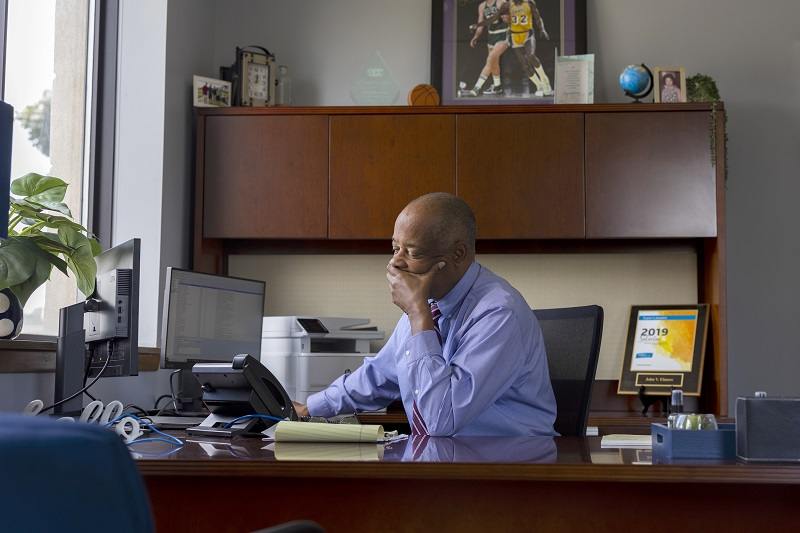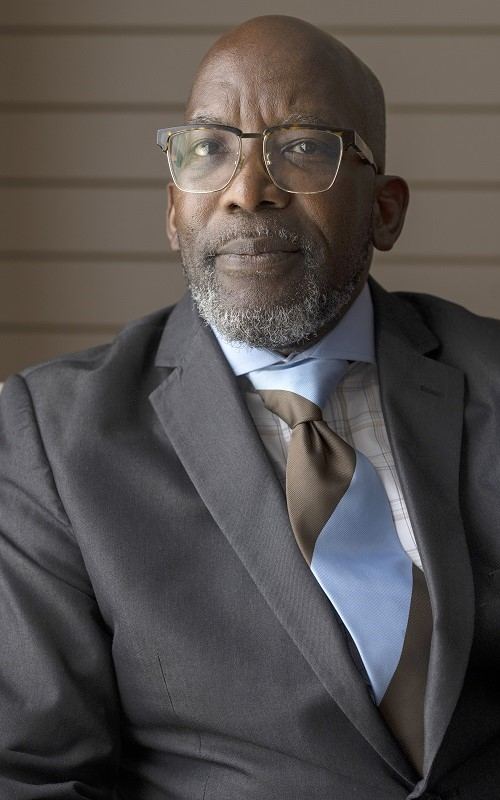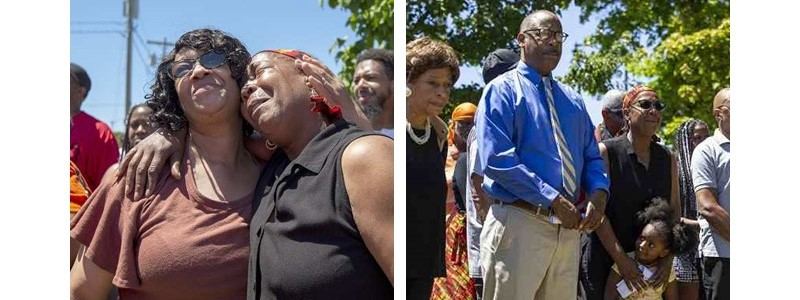The case of a lifetime

John Elmore talks with a client over the phone from his office in Buffalo, N.Y., on July 26. He is representing families of victims who were killed in a mass shooting at Tops Friendly Markets.
17:10 JST, August 8, 2022
BUFFALO, N.Y. – John Elmore’s newest clients had come to his law office in the last weeks to review their relatives’ autopsy reports, plan funerals and meet with investigators from the FBI, but lately they had also started showing up sometimes for seemingly no reason at all. Andrea Beckman parked outside a quiet strip mall, walked in a partially vacant office building, and knocked on her attorney’s door.
“Is it OK if I sit in here for a while?” she asked, and Elmore, 65, looked up from his computer and motioned to the chair across from his desk.
“Of course,” he said. “Do you need anything?”
“Just distraction. Just noise,” she said. “I’m still not doing that well when I’m at home by myself.”
It had been almost two months since her father went to buy a birthday cake for his 3-year-old son at a Tops grocery store and was shot and killed along with nine others, forcing Andrea to begin looking for a lawyer for the first time in her life. Her family knew of only one attorney in the Black community of East Buffalo – the one whose billboard towered above a gas station near Tops and whose slogan repeated in radio advertisements. “When they hurt you, I got you,” Elmore said. His personal injury practice consisted mostly of filing lawsuits for car accidents, dog bites, and slip-and-falls, and now he’d also come to represent several families of victims in a white supremacist terrorist attack that he considered the “most personal case of my career.”
He’d often shopped at that same Tops. He knew several of the victims from church or from his children’s youth sports leagues. And he had some idea of what it might be like for his clients to sort through the rage and the trauma of a mass shooting, because even four decades after another long-forgotten shooting, he was still doing that, too.
“How’s your family?” he asked. “How’s everyone holding together?”
“You know,” she said. “We’re all kind of spiraling.”
“What’s going on with your uncle? He called me last night at 1:30 in the morning, and he sounded a little confused.”
“Yeah, sorry about that. He’s in the hospital. They’re saying he basically had a mental breakdown from all of this.”
“Ugh. Poor guy,” Elmore said, as he reached into his desk for a yellow legal pad to take notes, because this was now the fulcrum of his work: to make a full accounting of the ever-expanding damages caused by yet another American mass shooting and then decide where and how to assign blame beyond the alleged shooter, Payton Gendron. Elmore had begun to explore potential lawsuits against social media websites, where the shooter had published racist diatribes and live-streamed a video of the attack; and against a body armor company that marketed its gear directly to civilians and sold the shooter a steel-plated vest that protected him from a security guard’s return fire; and against the manufacturer of his Bushmaster XM-15, which had been used to fire 30 shots in the first 20 seconds of the attack, and which the shooter wrote that he’d selected as his weapon of choice because it was a “dreaded military grade assault rifle” and “very deadly.”
Elmore had decided to partner on the case with the Giffords Law Center to Prevent Gun Violence and with Josh Koskoff, a Connecticut lawyer who’d won a $73 million settlement against gun manufacturer Remington Arms after the same style of semiautomatic weapon was used in the 2012 Sandy Hook Elementary School shooting. Koskoff had argued that Remington marketed its semiautomatic rifle specifically to impressionable young men, but the resolution of that case had taken almost a decade, and Elmore had cautioned his clients that their own lawsuit – if they even had one – would likely drag on for several years.
“Did you see Tops is reopening this week?” Andrea said. “They replaced the broken windows and redesigned it. It’s going back to being a regular grocery store.”
“Some people are lucky enough to move on,” Elmore said.
“It’s feels like nobody even talks about what happened in Buffalo anymore. It was a big deal for a few weeks, and now it’s gone.”
“I actually have some experience with that,” Elmore said, and he paused for a moment, trying to decide how much further to go. “Let me ask you something,” he said. “Did you ever hear about a mass shooting in Olean, New York?”
***
It was something he’d almost never talked about, but so much about the Tops shooting kept bringing him back to that day. His memories of Olean resurfaced in criminal records that described the Buffalo shooter as a “disaffected 18-year-old” and in the autopsies that detailed bullet wounds to the head and in the community forums he’d begun attending about America’s epidemic of mass shootings. One night after he left his law office, he met with six other community leaders to discuss potential solutions to gun violence.
“How many of these attacks have we had just since Buffalo?” asked one pastor, as they sat together inside a church the shooter had reportedly visited and scouted as a potential target days before the attack at Tops.
“At least three off the top of my head,” an anti-gun activist said.
“It’s rinse-repeat, and that’s been going on for what, a decade?”
“Forty-seven years,” Elmore said. The other men turned to look at him. They’d met several times to address gun trafficking and endemic gun violence in Buffalo, but Elmore had never told them exactly how he’d come to care.
“During my senior year, the first FBI-documented high school shooting happened at my school in Olean,” he said. “The shooter was actually a classmate of mine. He lived right down the block.”
“You’re kidding. I’ve never even heard of it,” the pastor said, so Elmore began to tell them about Anthony Barbaro, and how he’d sneaked into the high school during winter vacation on Dec. 30, 1974, shot and killed a janitor on the third floor, and then broken into the empty student council room that offered the best view of the surrounding neighborhood. Barbaro was the top marksman on the school’s rifle team, and he attached a telescopic sight to his long-range Remington rifle and started firing out the window and onto the street. Elmore had just gotten home from basketball practice when he heard the first reports come over the police scanner that his father, a firefighter, kept near the kitchen table. “Multiple gunshots. One victim down,” the police dispatcher said. Elmore listened on the scanner as first responders called in to say they were heading to the scene – local police, state troopers, the National Guard, and also the city’s No. 42 firetruck, driven by Elmore’s father, Herb. “Two minutes out,” he heard his father say.
He listened to the sound of at least a dozen more shots over the scanner, and then he thought he heard someone shout his father’s name. “We need help in the firetruck. Victim is critical,” someone said, and Elmore and his family kept listening and waiting for that help to arrive as Barbaro continued to fire. He shot at a gas company worker and then shot and killed a pregnant woman who happened to be driving by. Police officers tried to return fire with their pistols, but they realized they were outgunned and then took cover behind a wall. An ambulance driver arrived on the scene, and then turned around and drove off when the ambulance was hit by gunfire. Finally, the National Guard brought in a tank to help remove the victims, and Elmore and his mother rushed to the hospital. Three people were dead and 11 more were injured, including his father, who’d been shot once in his index finger and once directly through the top of his head.
“He had skull and bullet fragments embedded into his brain,” Elmore said. “He survived, but he came out different. His left side was paralyzed. He was crippled for the rest of his life.”
“Oh, no,” the pastor said.
“It was different in those days,” Elmore said. “No prayer vigil. No counseling. We never really talked about it. We just went back to school.”
They sat in silence for a moment as Elmore remembered the rest of that senior year. He’d taken over his father’s window cleaning business along with his younger brother to help make up for the family’s lost income and started driving his mother to work because she didn’t have her driver’s license. His father, a former All-Navy athlete who’d been the city’s first black firefighter, had finally come home from the hospital in a wheelchair with a missing finger, muscle tremors and a concave dent on the top of his head.
“One day you’re a carefree high school kid, and the next you’re a freaking adult,” Elmore said.
“You must have been so angry,” the pastor said.
“I’m still angry,” he said.
***

Alan Core runs a funeral home in Buffalo, N.Y. He buried three of the mass shooting victims, whom he knew through church.
He’d spent years sorting through the fallout of that mass shooting, and here he was again back at the very beginning, meeting in his office with a mortician and the family of another Buffalo victim he’d come to represent. Kat Massey, 72, had been buried after a funeral with a full viewing: eyes closed, lipstick freshly applied, her body at rest under an ornate blanket. “The very picture of peace,” one of the eulogists had said that day, but now Elmore wanted to know more about what Massey had looked like before, when she first arrived at the funeral home in a blue body bag.
“One thing we’re trying to establish with this case is the brutality of this weapon,” Elmore told the mortician, Alan Core. “At some point we might want to show what an AR-15 can do to the human body.”
Core winced and looked across the couch at Barbara Massey, Kat’s sister and next-door neighbor. “Some things shouldn’t even be whispered out loud,” Core said.
“It’s terrible to talk about, but people need to understand the ugliness,” Elmore said. “You’re one of the few people who knows the truth. You saw the before, and you gave us the after.”
“Oh, well, I don’t -” Core said, and then he closed his eyes and shook his head.
“Kat hated guns,” Barbara told him. “It’s OK. She would have wanted us to do everything possible to stop this insanity.”
Core played with the knot in his tie and considered how much to say. In three decades as a mortician, he had done the embalming and restorative work to enable open-casket viewings for the victims of motorcycle crashes, train-track suicides, drag-racing accidents and domestic violence murders, but he’d never encountered anything as violent as what he’d seen the morning after the shooting. He’d transported three bodies from the medical examiner’s office to the locked-and-refrigerated room in the back of his funeral home, unzipped the bags, and studied the remains of three elderly black women he had known and prayed with, and who happened to be shopping at Tops at the same time. Core was accustomed to dealing with the worst results of gun violence. Twenty percent of his business came because of shooting deaths, and he knew how to repair and disguise the bullet-sized entry and exit wounds of a 9mm, but he’d never witnessed the impacts of a semiautomatic rifle. Some of the victims in his funeral home had been shot multiple times, and the entry and exit wounds were the size of baseballs. The force of each bullet had created a shock wave through the body known as a cavitation effect, in which arteries, veins, and soft tissues were pushed away from the bullet’s pathway and then rebounded violently back into place, destroying them further. Muscles were torn. Organs were liquefied. Craniums were shattered. Bone fragments had turned to dust.
“My first reaction when I saw them, truthfully – I fell apart,” Core said now. “It took me away. I had a meltdown. For the first time in my life, my staff had to tell me to go home.”
He stopped and looked at Barbara. “I’m OK,” she said again. Elmore reached into his desk and took out a legal pad to write notes as Core went on.
“With a regular gun, you might have a small entry wound, but the body is left intact,” Core said. “With this, I’m figuring out what we’ve been left to work with and what we can put back into place.”
He told them that he’d left the funeral home that night, gone to church for a few hours to steady his mind, and then returned to begin the work of what he called “restoration art.” Massey had weighed 115 pounds, and she’d been hit twice at close range. “I put on my jazz music, and I talked to Kat as I worked,” Core told them. He explained how he’d combined remaining bone and skull fragments with meshing and papier-mâché to rebuild a cranial structure. He rebuilt part of an ear out of wax. He continued to work on Kat and the other victims over the next several days, injecting fluids to help their bodies firm up, taking skin grafts from other parts of the body, suturing pieces back together, and finally consulting with a beautician to re-create hair style, facial expression and skin tone.
Now he pulled out his phone and showed Barbara a picture of her sister lying in her casket. More than 500 people had come to say goodbye to her that day as Core stood nearby, making sure nobody touched her or tried to move her head. She was posed with her chin lifted high, her mouth formed into a smile and a kufi hat covering the top of her head.
“You did such a beautiful job,” Barbara told him. “I waited outside Tops for eight hours that day because I needed to see her and hold her hand. You’re the one who finally gave me that.”
“It was a privilege to set my hands on her,” he said. He put the phone back in his pocket, took off his glasses and wiped his eyes.
“The thing that haunts me is that I was put in a position to act like the creator,” he said. “I’m taking things that should always be intact and either remaking or reshaping to create that final portrait of a human being. From what I saw, that man had no heart for people. His goal was to obliterate. He wanted to erase.”
“Oh, Kat,” Barbara said. She started to cry, and Core reached for her hand.
“I’m sorry. I went too far,” he said, but Barbara shook her head.
Elmore set down his legal pad, stood from his chair and started to pace behind to his desk. “I hate to ask you this, but I think it might end up being helpful,” he said. “Did you take any pictures of your work?”
“I believe so,” Core said. “I’ll ask my staff.”
“Thank you,” Elmore said. “This is all a dark tunnel, but we have to explore it.”

Left : Wanda Willis comforts sister-in-law Barbara Massey Mapps during a dedication ceremony for Mapps’s sister Kat Massey in Buffalo on July 29.
Right : John Elmore stands with the family of Kat Massey during the sign dedication for her on Cherry Street in Buffalo, N.Y.
***

John Elmore displays a photo of his father, Herb Elmore, who was seriously wounded during a mass shooting at Olean High School in 1974.
He’d watched the live-streamed video of the Tops shooting, studied the 180-page document authorities said was written by shooter, consulted experts on white supremacist terrorism, and reviewed advertisements for semiautomatic weapons going back more than a decade. The artifacts of a mass shooting were stacked in folders on his desk, which made him wonder about all the questions he’d never asked in Olean. His family had rarely spoken about it. What he knew came mostly from Wikipedia, so one morning he drove out of Buffalo to visit his brother and several of his high school friends, hoping to learn more.
He traveled 70 miles over the Allegheny Mountains and into the small downtown, where the mayor had thrown a parade in 1975 to welcome Elmore’s father home from the hospital after brain surgery. Three thousand people had lined the streets to greet the ambulance while the high school band and cheerleaders performed in subzero temperatures. “Herbie’s home, and now we can put this nightmare behind us,” one local politician had said that day, and then the ambulance dropped Herb off at home in a wheelchair he was too proud to use, so Elmore began following his father around the house holding onto his belt to keep him from falling.
“Did Dad ever say anything to you about it?” Elmore asked, as he sat down for breakfast across from his younger brother, Robert.
“You know how he was,” Robert said, shaking his head. ” ‘Never look back. Don’t show any weakness. If you cry, I’ll give you something to cry about.’ “
“So he never told you how much he saw or what he remembered?”
“Not directly, but I heard some things,” Robert said, and he explained that a few years after the shooting, he’d listened to their father talking with a couple of firefighters who’d been with him that day inside the firetruck. They said Herb had gone into shock after the bullet hit his head, and he’d clamped his hand against the top of his skull to hold it in place. The other firefighters had tried to pry his hand away to assess the wound, but Herb was stronger than any of them. He’d kept his hand locked in place, which probably prevented him from bleeding to death.
“He sat there like that for two hours,” Robert said, shaking his head in disbelief.
“Two hours?” Elmore said. “Come on.”
“I went back and looked,” Robert said. “It was at least that long before they could get him out with the tank.”
Herb had come home a few months later, relearned how to walk with a cane, started a swimming club for people with disabilities, and gone in person every two weeks to pick up his disability check at the firehouse so he had an excuse to see his old colleagues. Meanwhile, Elmore had left for college the next fall and followed his father into a job as a first responder. He’d become a police officer in Syracuse, N.Y, until one afternoon when a teenager in mental distress started screaming racial slurs at him and swinging at his head with a large metal rake. Elmore had pulled out his .357 Magnum, and he’d realized in that moment that under no circumstances could he pull the trigger. He’d holstered the gun and escaped into his police cruiser. A month later he was in law school, and he’d never owned or carried a gun again. He’d taken on murder trials and death penalty cases, losing himself in other people’s traumas and returning to Olean every few weeks to visit his father until he died at age 64 of a cancer that doctors said was potentially related to the bullet fragments still embedded into his brain.
“We had a lot of good years stolen,” Elmore said. “I try to be a positive person, but I’ve been thinking about that.”
“Sure, because you’re living it again,” Robert said, and Elmore nodded.
“I can already tell this case is going to age me,” he said. “It’s pressure. It’s late nights and seeing so much grief.”
“Plus the violence,” Robert said.
“Here we are 50 years later, still dealing with the same problems,” Elmore said, and he pushed away his empty coffee cup and thought for a moment about the similarities between the mass shootings in Buffalo and Olean: two disaffected teenagers armed with militaristic weapons, each firing more than 30 shots into a public space, targeting random strangers and transforming entire families in ways Elmore thought his clients were only beginning to comprehend. It seemed to him that a mass shooting created its own kind of cavitation effect – everything flung apart upon impact and then rebounding into place broken, torn, swollen, stretched, altered.
“He was really holding his head together all that time?” Elmore asked again. “He was alert? He was conscious?”
His brother nodded.
“Two hours,” Elmore said again, and he touched his head and looked at a clock in the diner, watching the seconds pass.
***
“How much longer will all of this last?” Barbara Massey asked one day as she sat in Elmore’s office a few months after shooting. She’d been filling her days by responding to all 430 condolence letters mailed to her sister’s house. She’d gone in person to each of Gendron’s court appearances to keep track of the legal proceedings. She’d mowed her sister’s lawn, weeded the flower bed, dusted the house, organized the photo albums, and cut the grass again.
“I like to feel like things are moving forward,” she told Elmore. “I need to be busy. It’s the only thing that helps.”
“That was me, too,” Elmore said. “As long as I had a job to do, I could act like I was OK.”
“I have moments when I think I’m starting to do a little better,” Barbara said. “I’ve been listening to what the pastors say when they talk about forgiveness. It sounds right to me. I try. But each time I see him walk into court, my whole body starts to shake. I feel like his eyes should be glued open, there should be mirrors put in front of him, and then I’d like to shoot that little maggot in the back of his head.”
She squeezed the table. “I’m sorry,” she said. “This has opened up a rage and a despair inside me that I didn’t even know I owned.”
“His justice is coming,” Elmore said, and he began to update her on the case. Gendron was facing murder charges in New York and 27 federal counts for hate crimes and firearm charges. His defense team had entered a plea of “not guilty” and requested a one-year delay, which meant the criminal case would last a long time and the civil cases would last much longer, but the timeline that concerned Barbara was more fundamental.
“Some days it hurts so bad I don’t know how much longer I can take it. When does it end?” she asked, and 47 years later, Elmore thought he knew the answer.
“I’m not sure that it does,” he said.

John Elmore walks into the Tops Friendly Markets store in Buffalo, N.Y., where, in May, a mass shooter killed 10 people.





